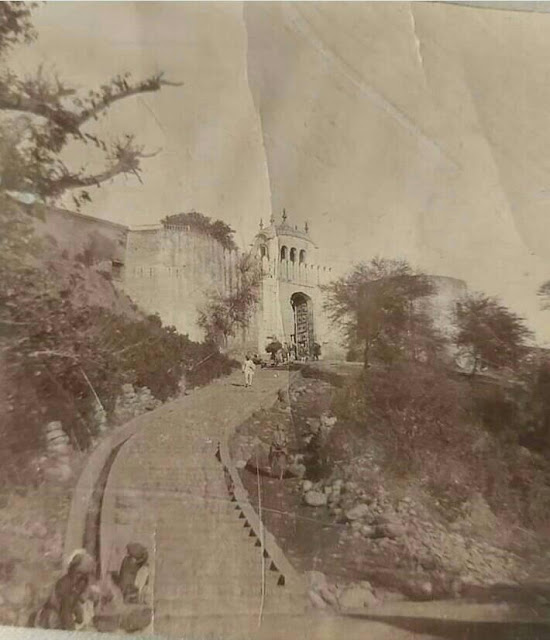I was just walking through some documents I had saved over the years, when it struck me that there has been very little new research work or relook into the history of the hill states. One particular format has been the examination of oral ballads, very few of which seem to be available in popular culture today. However, that was certainly not the case in the British era, when much field work seems to have been done by scholars of Europe on the subject, as they panned across the state of the Lahore kingdom and their adjunct territories. Sirmour was a Small Princely state along the Yamuna river's course While their purpose may have been malevolent in nature, many interesting insights got captured over the course of their work, and replication or improvement on the same seems to be rather scarce, especially in the context of what the European scholars used to call the "Punjab Hill States". One such case was on Sirmour, where very little information can be found in the publi...
The year was 1808. The place, Jammu.
Raja Jaid Singh was placed on the throne of Jammu to be its king, supported by the presence of Mian Mota Singh, the all-powerful kingmaker of Jammu. In this period of madness in the province of Jammu, one hoped that Jammu would witness a semblance of balance and stability being created. Jammu had been in a free fall following the death of Raja Brijraj Dev. Sampuran Singh, the successor, succumbed to smallpox, leading to the situation that a new successor had to be found desperately. In the scramble, the name of Jaid Singh came forward, and with Mian Mota Singh’s support, Jaid Singh ascended the throne.
.jpeg) |
| Raja Brijraj Dev of Jammu (painting with San Diego Museum of Art) |
Contributing to the constant madness in Jammu were the Khalsa forces who would raid Jammu and pillage it constantly, devoiding it of its wealth. The 1783 pillage of Jammu remained afresh in the minds of the people and the aristocrats alike - for two months, one witnessed not a single day when the Khalsa did not seize property and plundered anything they could find their hands on.
It was often accused that he had grown up amongst women and thus Delhi had any control on the functioning forcing Mian Mota Singh to intervene in the functioning. And the accusations started to prove themselves right, as the foundations were standing on an unstable, uneasy equilibrium. Raja Jaid Singh failed to get a grip on the government and the administration. However, he did not spare an opportunity to differ from Mian Mota Singh just to prove a point. Whatever was lagged in terms of administrative talent was more than made up in courtroom politics by Raja Jaid Singh.
Thanks to the ineffective manoeuvring, one witnessed the encirclement of Jammu yet again from all sides with revolts from the Khalsa chieftains who had been granted territories and forts by the Khalsa fauj following the Battle of Ranjitgarh. Bagh Singh Akhuwala and Nar Singh, Haqiqat Singh and Gurbaksh Singh Dod raised their heads in revolt once again, and in a bid to divide and conquer, Jaid Singh chose to establish relations with Bhai Hukma Singh Chimni, an important Lahore darbar chief. Without involving or consulting Mian Mota Singh, Jaid Singh instead chose to meet Chimni in 1809. Jaid Singh even granted the ilaqa of Sayedgarh, hoping this will help stave off contests from other Khalsa strongmen, and buy his loyalty.
Of course, the foolhardiness of Jaid Singh was to prove costly for not just him, but for Jammu too. Chimni had bigger ambitions, and chose to invade Jammu the same year with a huge force. Wading through the Tawi’s waters, the force reached the Gummat gate to lay siege on Jammu and annex it by any means.
 |
An old pic of Gummat Gate (courtesy: Booster Vikram Singh’s Facebook page) |
It was in this moment that Mian Mota Singh took charge and scrambles a handful of forces to defend the city and honour of Jammu. Thanks to the lack of sufficient trained soldiers, it seemed that there was no one to stand up to the muskets and waving swords of Chimni’s forces, and they kept coming up.
In this moment came forward one young man who was already being hailed as a wise man beyond his years, demonstrating a sense of bravery and the will to fight that only a few would demonstrate that day on either side. Gulab Singh, one of the soldiers fighting with Mian Mota Singh (apart from being his nephew), took charge. Sword in hand, he jumped right into battle, and displayed his agility and strength simultaneously. Joined by a couple of other Rajputs, the trio fought viciously, with Gulab Singh personally scalping a few chief men of Chimni’s forces. Such was the fierce counterattack that Chimni’s forces were compelled to fall back from the staircase.
The reputation travelled far and wide, and soon reached Lahore. Mian Mota Singh visited the Lahore Darbar, only to be asked by Maharaja Ranjit Singh about that ‘young boy’ who warded off Hukma Singh Chimni. Upon knowing of him, Ranjit Singh called on Gulab Singh to come and join the Gorchara Khas troops of Ranjit Singh.
 |
| Portrait of Raja Gulab Singh from around 1845, now with British Library |
And it was thus that Gulab Singh came into the service of the Lahore Darbar, on the reputation that he had earned that day at Gummat Gate. Thus were sown the seeds of the man who would go on to be called Napoleon of India, and create an empire that changed the geographical boundaries of India forever.
Comments
Post a Comment